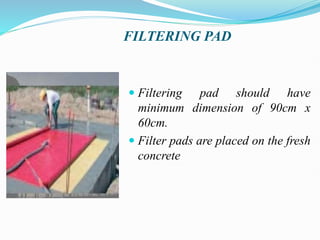vacuumconcrete- 190731131507.pdf
- 2. VACUUM CONCRETE  Vacuum concrete is the type of concrete in which the excess water is removed for improving concrete strength.  The water is removed by use of vacuum mats connected to a vacuum pump.  The main aim of this technique is to extract extra water from concrete surface using vacuum dewatering.
- 4. PROCEDURE ï‚— In the usual manner, a concrete mix with good workability is pace in the form-works. ï‚— As fresh concrete contains continues the system of water-filled channels, the application of a vacuum to the surface concrete results in a large amount of a vacuum to the surface of the concrete. ï‚— This results in a large amount of water being extracted from a certain depth of the concrete.
- 5. ï‚— The vacuum is applied through porous mats connected to a vacuum pump. ï‚— The final water cement ratio before setting is thus reduced and as this ration largely controls the strength, vacuum concrete has a higher strength and also density a lower permeability and a greater durability.
- 7. NEEDS  The chemical reaction of cement with water requires a water-cement ratio of less than 0.38  Workability is also important for concrete  Workability and high strength don’t go together as their requirements are contradictory to each other  Vacuum concrete is the effective technique used to overcome this contradiction
- 8. COMPONENTS  There is a marked reduction in effective water- cement ratio and the performance of concrete improves drastically.  This improvement is more on the surface. 1) Vacuum pump 2) Water separator 3) Filtering pad 4) Screed board vibrator
- 9. VACUUM PUMP ï‚— A vacuum pump is a device that removes gas molecules from a sealed volume in order to leave behind a partial vacuum. ï‚— Vacuum pump are categorized as gas transfer pumps and gas binding or capture pumps.
- 10. WATER SEPARATOR ï‚— Water separators are mechanical separators that are typically installed downstream of the air compressor tanks. ï‚— Depending on compressed air temperature, water separators are able to remove 40-60% of water
- 11. FILTERING PAD ï‚— Filtering pad should have minimum dimension of 90cm x 60cm. ï‚— Filter pads are placed on the fresh concrete
- 12. SCREED BOARD VIBRATOR  Screed vibrator is used for the levelling as well compaction of concrete  It consists of high quality steel bar  Special water protective vibrator motor is mounted in the centre which produces 1830N centrifugal force which is most ideal
- 14. VACUUM DEWATERING OF CONCRETE
- 15. LAYOUT OF VACUUM DEWATERED FLOORING
- 16. ADVANTAGES  Both workability and high strength are achieved  Reduction in water-cement ratio may increase the compressive strength by 10-50% and lowers the permeability  It enhances the wear resistance of concrete surface  The surface is plain and smooth due to reduced shrinkage  The formwork can be removed early
- 17. DISADVANTAGES  High initial cost  Need trained labour  Need specific equipment  Need power consumption  The porosity of concrete allows water, oil and grease to seep through, consequently weakening the concrete
- 18. APPLICATIONS Industrial floor sheds like cold storages Hydro power plants Bridges ports and harbour Cooling towers
- 19. THANK YOU


















